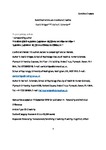Sensitive individuals are more creative
| dc.contributor.author | Bridges, D | en |
| dc.contributor.author | Schendan, HE | en |
| dc.date.accessioned | 2018-09-11T16:30:34Z | |
| dc.date.issued | 2019-05-01 | en |
| dc.identifier.issn | 0191-8869 | en |
| dc.identifier.uri | http://hdl.handle.net/10026.1/12342 | |
| dc.description.abstract |
Individual differences in cognition, affect, and personality have been explored extensively as factors in creativity, but pinpointing the exact factors has remained elusive. This review proposes that a major gap has been lack of research on the relation between creativity and temperament, which captures the biologically-based core of personality, especially studies on sensitive temperament. Sensitivity has been associated with creativity anecdotally and in early work but rarely investigated recently, particularly using recent more precise definitions of sensitivity and state-of-the-art sensitivity and creativity assessments, nor has the relationship between creativity and cognitive processes that should reflect sensitive neural processing been investigated. This review also aims to identify cognitive abilities that characterize sensitivity and their implications for creativity, concluding that orienting sensitivity is the most important trait in the multiple trait temperament of sensitivity that predicts higher creativity. Sensitive, open people are more creative due to a complex interplay of multiple traits and their associated biological pathways, which originate from plasticity genes that interact with environmental and experiential contexts to influence development of neurotransmitter systems, neurosensitivity mechanisms (especially lower inhibition), and brain networks for automatic attention and orienting. | en |
| dc.format.extent | 186 - 195 | en |
| dc.language.iso | en | en |
| dc.publisher | Elsevier | en |
| dc.rights | Attribution-NonCommercial-NoDerivatives 4.0 International | en |
| dc.rights | Attribution-NonCommercial-NoDerivatives 4.0 International | en |
| dc.rights | Attribution-NonCommercial-NoDerivatives 4.0 International | en |
| dc.rights | Attribution-NonCommercial-NoDerivatives 4.0 International | en |
| dc.rights | Attribution-NonCommercial-NoDerivatives 4.0 International | en |
| dc.rights.uri | http://creativecommons.org/licenses/by-nc-nd/4.0/ | en |
| dc.rights.uri | http://creativecommons.org/licenses/by-nc-nd/4.0/ | en |
| dc.rights.uri | http://creativecommons.org/licenses/by-nc-nd/4.0/ | en |
| dc.rights.uri | http://creativecommons.org/licenses/by-nc-nd/4.0/ | en |
| dc.rights.uri | http://creativecommons.org/licenses/by-nc-nd/4.0/ | en |
| dc.subject | Personality | en |
| dc.subject | Temperament | en |
| dc.subject | Sensitivity | en |
| dc.subject | Creativity | en |
| dc.subject | Plasticity | en |
| dc.subject | Cognition | en |
| dc.subject | Affect | en |
| dc.title | Sensitive individuals are more creative | en |
| dc.type | Journal Article | |
| plymouth.volume | 142 | en |
| plymouth.publisher-url | http://www.elsevier.com/locate/paid | en |
| plymouth.journal | Personality and Individual Differences | en |
| dc.identifier.doi | 10.1016/j.paid.2018.09.015 | en |
| plymouth.organisational-group | /Plymouth | |
| plymouth.organisational-group | /Plymouth/REF 2021 Researchers by UoA | |
| plymouth.organisational-group | /Plymouth/REF 2021 Researchers by UoA/UoA04 Psychology, Psychiatry and Neuroscience | |
| plymouth.organisational-group | /Plymouth/Research Groups | |
| plymouth.organisational-group | /Plymouth/Research Groups/Centre for Brain, Cognition and Behaviour (CBCB) | |
| plymouth.organisational-group | /Plymouth/Research Groups/Centre for Brain, Cognition and Behaviour (CBCB)/Brain | |
| dcterms.dateAccepted | 2018-09-11 | en |
| dc.rights.embargodate | 2020-09-18 | en |
| dc.rights.embargoperiod | Not known | en |
| rioxxterms.version | AM | en |
| rioxxterms.versionofrecord | 10.1016/j.paid.2018.09.015 | en |
| rioxxterms.licenseref.uri | http://creativecommons.org/licenses/by-nc-nd/4.0/ | en |
| rioxxterms.licenseref.startdate | 2019-05-01 | en |
| rioxxterms.type | Journal Article/Review | en |
| plymouth.funder | CogNovo: Cognitive Innovation::Research Executive Agency European Union FP7 | en |
| plymouth.funder | CogNovo: Cognitive Innovation::Research Executive Agency European Union FP7 | en |



